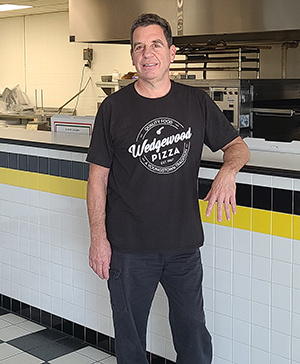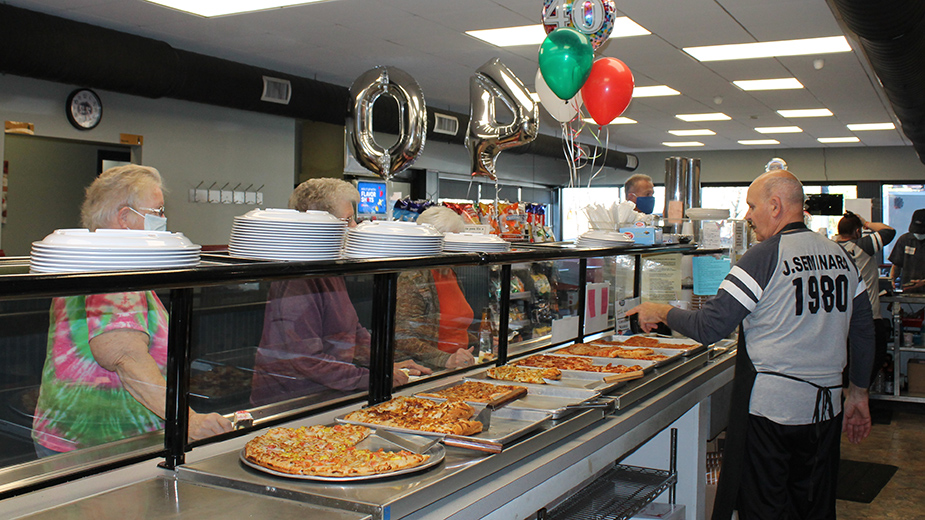YOUNGSTOWN, Ohio – If you want to start an argument in a Youngstown bar, ask the people around you who has the best pizza in town.
You’ll get passionate responses from diehard supporters defending their favorites.
But one thing they will all agree on is that the Mahoning Valley has great pizza.
Geographically, the area sits on a fault line of the pizza continuum. It’s where the classic thin-crust, round pies that emanate from New York City transform into the thicker, sweeter, heartier – and usually square – pizza of the Midwest.
And the Valley has no shortage of this distinctive style.
There are anomalies, too, of course. Youngstown is the birthplace of Brier Hill pizza, the unique variation marked by a roasted pepper-infused sauce and topped with grated Romano cheese. And there will always be a handful of New York-style shops.
But they’re not the dominant local pizza style, which is rooted in recipes developed by Italian immigrants at the turn of the century, and which befits a blue collar, family-oriented city.
There is no official name for the pizza of the Mahoning Valley. But Katherine DeToro, chief marketing officer of Pizza Joe’s, calls it ‘Grandma-style,” which reflects its history and its heartiness.
COMPANY ORIGINS
Pizza Joe’s was founded in downtown New Castle, Pa., in 1980 by DeToro’s father, Joe Seminara. It now has 42 locations (17 in Ohio), making it the Youngstown-New Castle area’s largest pizza chain.
While DeToro acknowledges the region’s affinity for tradition, it doesn’t stop Pizza Joe’s from innovating.
“When you’re in the shop as much as we are, you get tired of eating the same thing, so we mess around with stuff,” she says. One example is the chain’s award-winning “hot and zippy sauce,” which is spicy and hot.
Pizza Joe’s has a new product in development but DeToro is keeping it under her hat until it’s ready for the marketplace.
The Seminara family began franchising in 1985, beginning with its Ellwood City, Pa., location, which was the chain’s fifth overall branch. It still owns four shops, with the remaining 38 being franchisee-owned.
Like many pizza chain founders, Seminara learned the art from family, with lots of trial and error along the way.
“Our dough has stayed consistent since the beginning,” DeToro says. “Grandma was in the shop every day at the beginning, making the dough.”
The technology has changed over the years; the need for speed has led the chain to adopt conveyor belt ovens instead of the traditional deck oven found in most pizza shops.
“We have to be faster,” DeToro says.
Mike Liberato, who has owned the original Belleria Pizza shop since 2006, tells a similar origin story.
“My grandmother and one of her sisters took my great-grandmother’s recipe and started selling pizza at the Lowellville Italian festival in 1957,” Liberato says. “It went so well that they did it full-time.”
The first Belleria opened in 1958 on Albert Street on Youngstown’s east side. It moved to Logan Avenue on the north side in 1977, and then to its current location on Wick Avenue in 2006.
There are now nine locations. Liberato maintains a bit of autonomy from the other shops – which are franchises that are overseen by family members – but all use the same original recipes.
Steve Cocca, who owns the nine-store Cocca’s Pizza chain, traces his company to 1982. That’s when his parents opened a shop on Market Street in Boardman because his mother wanted to start a business now that her children were grown.
Cocca opened his second location in 2003, realizing his family’s dream of having a chain of pizza shops.
“COVID has stalled that process, but our eyes are always out there looking … to open store No. 10,” he says.
His mother still comes in to the Boardman or Canfield location a day or two each week to “crack the whip,” Cocca says. “It’s great to have her there and get her opinions. In Italy, her family had a grocery store, and she is wise about the products.”
With just three locations, Wedgewood Pizza is a small chain but one of the Valley’s biggest names.
Founded in Austintown in 1967 by Pasquale Acconcia, who later took on Fernando Riccioni as a partner, Wedgewood opened its Boardman location in in 1995.
Anthony Pellegrini is the only owner and operator the Boardman shop has ever had. He learned the business, from his uncle, Riccioni.
“I worked at the Austintown store for 20 years before opening [the Boardman store],” Pellegrini says. “I knew all of the recipes, and I still use the same ingredients and from the same brands.”
CURRENT WOES
The area’s pizza chains have something else in common other than similar origin stories.
The COVID-19 pandemic has brought a turmoil to the industry that ranges from skyrocketing ingredient costs to a shortage of labor. As a result, owners have had to raise prices, cut hours and close dining rooms.
It’s the same issue facing many industries. But it’s more personal for pizza purveyors, who tend to have a base of loyal customers.
Dealing with the ingredient shortages is “a constant battle,” says Wedgewood’s Pellegrini.
“It’s chicken one week, wings another week, then salami, and then steak another week,” he says. “Chicken wings have been an issue for a while and that drives up the price. And pepperoni has gone up 25% in the last four months.”

Despite the fluctuations, Pellegrini keeps his prices constant for as long as possible – except for the wings.
“I had to raise the price of wings,” he says. “I can’t eat that price increase. Now, I just say ‘call for prices,’ like as if it’s lobster.”
At the moment, an order of 10 wings is $12. “I’m not making much money on them,” Pellegrini says.
Julienned salami is a trademark topping on the house special pizza at Wedgewood. But when getting pre-sliced salami became hard to get during the pandemic, Pellegrini resorted to buying it by the roll and slicing it up in-store.
“That’s how we used to do it back in the 1970s when I first started with Fernando,” he says.
Pellegrini employs 25 at his shop and admits to having a bit of difficulty staying at full staffing.
“I try to take care of them so they stay,” he says. “If an employee leaves, the one that replaces him won’t be as good as the one you had.”
Belleria owner Liberato closed his dining room during the pandemic like every restaurant. But he has yet to reopen it and has no plans to do so.
“I only have 32 seats and this has always been a mostly takeout place anyway,” he says, explaining that dine-in receipts accounted for no more than 10% of his sales.
Liberato did briefly reopen the dining room in June but closed it because his employees felt safer with fewer people in the building. “I didn’t want to have my workers quitting,” he says, because finding new workers is harder than ever.
“They used to stay at least a few months,” Liberato says. “I recently hired a girl who quit in 90 minutes.”
The pandemic brought on a consumer shift toward takeout, which was good for pizza sales. “But if you don’t have employees, it’s not a good thing,” he says. “We’re trying to find the sweet spot between the amount of business we do and the number of employees we have.”
While food distributors are raising prices on everything from sausage to oil, labor costs are rising even faster.
“My labor costs are up by 50% or 60%,” Liberato says. “I have to hire 16-year-olds with no experience at $12 an hour. That, and the increase in taxes related to it, has been the biggest rise.”
As a result, he raised prices on all of his menu items in June. “I was thinking [prices] were going to settle down but they haven’t,” he says.
Cocca says the skyrocketing cost of supplies that hit other industries has moved on to the food industry.
“Food costs are elevated and it’s forcing everyone to raise prices,” he says. “It’s out of our control. I’ve been fortunate with my wholesaler [in getting ingredients and raw food] but others have had to shift to a product that’s not as good. The price of chicken wings and oil has gone up dramatically.”
Cocca, whose stores include three pizza restaurants that sell liquor and require many employees, says finding enough help is his toughest problem.
DeToro, of Pizza Joe’s, says the problem with finding workers goes beyond raising pay.
“It’s not money,” she says. “I’m tired of reading that we don’t pay enough or offer benefits. Most of us do. To me, it’s deeper. For people in the service and hospitality industries, it’s more philosophical. They got a taste of what it’s like to not work 80 hours a week [during the government-mandated shutdown of restaurants].”
DeToro defends service industry workers. “They have skills that others don’t possess,” she says, referring to customer service, speed and multitasking.
The United States has always had a culture of working as much as possible, she says, and many employees have recently learned that a better work-life balance makes them happier.
“We’ve seen the shift,” DeToro says. “Some of our stores are taking an off day, not being open seven days a week. And there is nothing wrong with that. We’re starting to see a culture shift. [Pizza consumers] will say, ‘I have the luxury of working only five days a week. Why not also give [service industry workers] a day to take care of stuff, like go to the doctor?’”
DeToro says Pizza Joe’s takes care of its employees.
“We’ve been fortunate,” she says. “At most of our locations, we have employees who have been there since the beginning.”
Pictured at top: Joe Seminara, founder of Pizza Joe’s, serves customers in the flagship location in downtown New Castle, Pa. The pizza chain, which is the area’s largest with 42 locations, marked its 40th anniversary last year.
